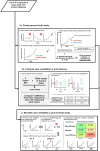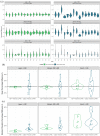In Silico Modeling Demonstrates that User Variability During Tumor Measurement Can Affect In Vivo Therapeutic Efficacy Outcomes
- PMID: 36465983
- PMCID: PMC9716635
- DOI: 10.1177/11769351221139257
In Silico Modeling Demonstrates that User Variability During Tumor Measurement Can Affect In Vivo Therapeutic Efficacy Outcomes
Abstract
User measurement bias during subcutaneous tumor measurement is a source of variation in preclinical in vivo studies. We investigated whether this user variability could impact efficacy study outcomes, in the form of the false negative result rate when comparing treated and control groups. Two tumor measurement methods were compared; calipers which rely on manual measurement, and an automatic 3D and thermal imaging device. Tumor growth curve data were used to create an in silico efficacy study with control and treated groups. Before applying user variability, treatment group tumor volumes were statistically different to the control group. Utilizing data collected from 15 different users across 9 in vivo studies, user measurement variability was computed for both methods and simulation was used to investigate its impact on the in silico study outcome. User variability produced a false negative result in 0.7% to 18.5% of simulated studies when using calipers, depending on treatment efficacy. When using an imaging device with lower user variability this was reduced to 0.0% to 2.6%, demonstrating that user variability impacts study outcomes and the ability to detect treatment effect. Reducing variability in efficacy studies can increase confidence in efficacy study outcomes without altering group sizes. By using a measurement device with lower user variability, the chance of missing a therapeutic effect can be reduced and time and resources spent pursuing false results could be saved. This improvement in data quality is of particular interest in discovery and dosing studies, where being able to detect small differences between groups is crucial.
Keywords: 3D-TI; Tumor models; efficacy study; in silico; in vivo; study reproducibility; tumor imaging.
© The Author(s) 2022.
Conflict of interest statement
The author(s) declared the following potential conflicts of interest with respect to the research, authorship, and/or publication of this article: Fuel3D is developing BioVolume and claims financial competing interests on the product. There are specific patents granted and filed for this technology or any part of it. Fuel3D provided support in the form of salaries for authors, but did not have any additional role in the study design, data collection and analysis, decision to publish, or preparation of the manuscript. In vivo work was carried out by BioVolume users who were not employed by Fuel3D and who did not receive financial compensation.
Figures







Similar articles
-
Comparing Variability in Measurement of Subcutaneous Tumors in Mice Using 3D Thermal Imaging and Calipers.Comp Med. 2022 Dec 1;72(6):364-375. doi: 10.30802/AALAS-CM-22-000033. Comp Med. 2022. PMID: 36744510 Free PMC article.
-
A technique for semiautomatic segmentation of echogenic structures in 3D ultrasound, applied to infant hip dysplasia.Int J Comput Assist Radiol Surg. 2016 Jan;11(1):31-42. doi: 10.1007/s11548-015-1239-5. Epub 2015 Jun 20. Int J Comput Assist Radiol Surg. 2016. PMID: 26092660
-
User-dependent variability in mitral valve segmentation and its impact on CFD-computed hemodynamic parameters.Int J Comput Assist Radiol Surg. 2019 Oct;14(10):1687-1696. doi: 10.1007/s11548-019-02012-1. Epub 2019 Jun 19. Int J Comput Assist Radiol Surg. 2019. PMID: 31218472
-
Subgroup analyses in randomised controlled trials: quantifying the risks of false-positives and false-negatives.Health Technol Assess. 2001;5(33):1-56. doi: 10.3310/hta5330. Health Technol Assess. 2001. PMID: 11701102 Review.
-
Daily stereotactic ultrasound prostate targeting: inter-user variability.Technol Cancer Res Treat. 2003 Apr;2(2):161-70. doi: 10.1177/153303460300200213. Technol Cancer Res Treat. 2003. PMID: 12680798 Review.
Cited by
-
Trends in Subcutaneous Tumour Height and Impact on Measurement Accuracy.Cancer Inform. 2023 Apr 19;22:11769351231165181. doi: 10.1177/11769351231165181. eCollection 2023. Cancer Inform. 2023. PMID: 37113645 Free PMC article.
-
Overlooked poor-quality patient samples in sequencing data impair reproducibility of published clinically relevant datasets.Genome Biol. 2024 Aug 16;25(1):222. doi: 10.1186/s13059-024-03331-6. Genome Biol. 2024. PMID: 39152483 Free PMC article.
References
-
- Euhus DM, Hudd C, LaRegina MC, Johnson FE. Tumor measurement in the nude mouse. J Surg Oncol. 1986;31:229-234. - PubMed
-
- Brough D, Smith A, Turley K, Amos H, Murkin J. Reducing inter-operator variability when measuring subcutaneous tumours in mice: an investigation into the effect of inter-operator variability when using callipers or a novel 3D and thermal measurement system. MetaArXiv Preprint. Posted online October 8, 2021. doi:10.31222/osf.io/hvfpx - DOI
LinkOut - more resources
Full Text Sources

